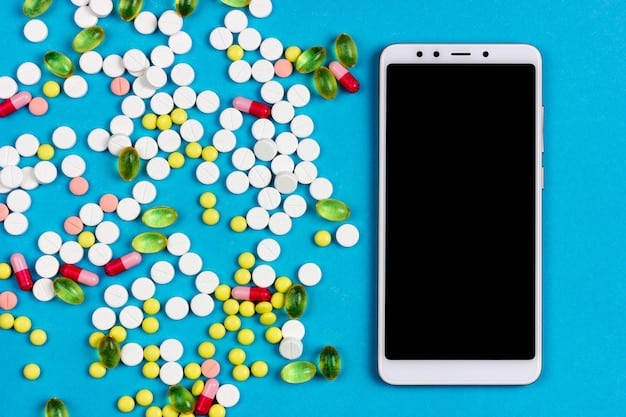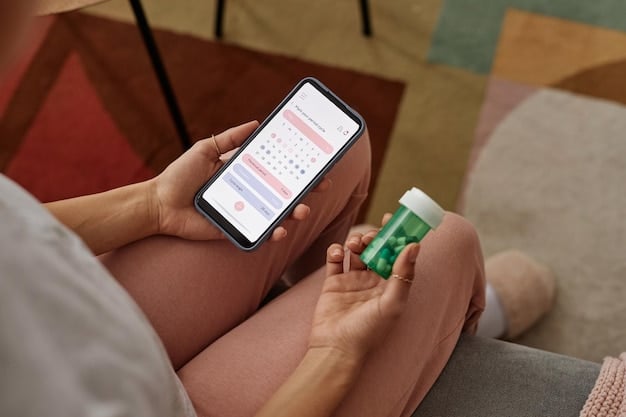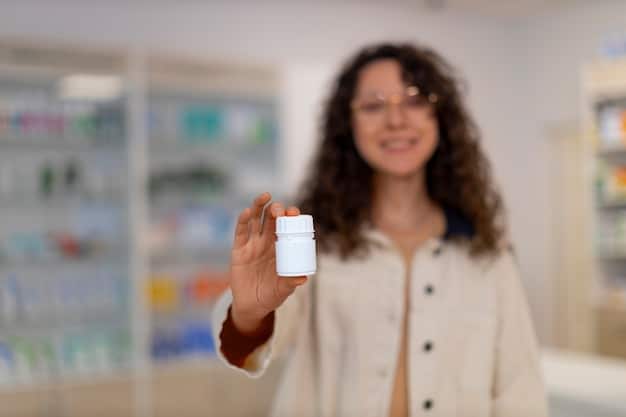Apps to Save on Prescriptions: Compare Pharmacy Prices

Navigating the complex landscape of prescription drug costs in the US can be overwhelming, but several innovative apps empower consumers to significantly reduce expenses by comparing pharmacy prices nationwide, ensuring easier access to affordable medications for millions.
In an era where healthcare costs continue to climb, finding ways to save on essential expenses, particularly prescription medications, has become a priority for many Americans. The good news is that technology offers practical solutions to this pressing issue. This article explores how you can effectively use mobile applications to save on prescriptions: compare prices at pharmacies nationwide with these apps, transforming the way you manage your healthcare budget.
the rising cost of prescriptions in the US and the need for savings
The United States faces a unique challenge with prescription drug pricing. Unlike many other developed nations, there isn’t a centralized system for drug price negotiation, leading to significant variations in costs even within the same city. This often leaves consumers feeling helpless and struggling to afford necessary medications, sometimes even deciding between their health and other essential expenses.
For many, the burden of prescription costs is not just about expensive specialty drugs; it also affects widely used generic medications. This unpredictability creates a climate of financial anxiety, forcing patients to make difficult choices about their health. Understanding this landscape is the crucial first step in finding effective solutions.
understanding prescription pricing variability
Several factors contribute to the wide range of prescription prices across different pharmacies and locations. These include:
- Pharmacy Chains vs. Independents: Larger chains often have different purchasing agreements than independent pharmacies, influencing their pricing.
- Geographic Location: Prices can vary significantly from urban to rural areas, and even between neighborhoods in the same city.
- Insurance Coverage and Deductibles: A patient’s insurance plan, its formulary, and the status of their deductible can drastically alter out-of-pocket costs.
The lack of transparency in drug pricing further complicates matters, making it difficult for consumers to know if they are paying a fair price without dedicated tools. Patients often discover price disparities only after reaching the pharmacy counter, a moment of acute vulnerability.
the urgency of finding cost-saving solutions
The financial impact of high prescription costs can be profound, leading to medication non-adherence, which then results in worsened health outcomes and increased future healthcare expenditures. For individuals managing chronic conditions, consistent access to their medications is non-negotiable. Therefore, empowering consumers with tools to find lower prices is not just about saving money; it’s about improving public health and ensuring equitable access to care.
Many patients are simply unaware that prescription prices can vary so much, or that tools exist to help them navigate these differences. This knowledge gap highlights the importance of raising awareness about available resources that can significantly alleviate their financial burden and stress related to medication costs.
introducing prescription price comparison apps
In response to the opaque and often high cost of medications, several innovative mobile applications have emerged, designed to bring transparency and savings directly to the consumer. These apps act as powerful comparison tools, allowing users to search for their prescriptions and instantly view prices at various pharmacies in their vicinity and even nationwide.
These platforms typically leverage extensive databases of drug prices, updated regularly, to provide accurate and real-time information. By simply entering the name of their medication, dosage, and zip code, users can quickly identify the most affordable options, often alongside coupons or discount codes that can further reduce the cost.
how these apps work: a straightforward process
The core functionality of these apps is remarkably user-friendly:
- Search by Drug Name: Users type in the generic or brand name of their prescription.
- Specify Dosage and Quantity: Accuracy in dosage and quantity ensures precise price comparisons.
- Enter Location: A zip code or current location helps the app find nearby pharmacies.
- Compare Prices: The app displays a list of pharmacies, their prices for the requested medication, and applicable discounts.
- Redeem Savings: Users can often present a digital coupon or a membership ID from the app at the pharmacy to receive the discounted price.
This streamlined process removes the guesswork and the need to call multiple pharmacies, saving consumers significant time and effort. It empowers them to make informed decisions about where to fill their prescriptions.
the value proposition: Convenience and significant savings
Beyond the immediate financial benefits, these apps offer unparalleled convenience. They eliminate the need for extensive manual research and provide a sense of control over healthcare expenditures. For many, the savings can be substantial, sometimes turning a prohibitively expensive medication into an affordable one. This aspect is particularly vital for those without comprehensive insurance coverage or facing high deductibles.
Furthermore, these tools are not just for the uninsured. Even individuals with robust insurance plans can often find better prices using these apps than through their insurance co-pay, especially for generic drugs. This highlights their broad utility across various patient demographics, making prescription savings accessible to nearly everyone.

top apps to save on prescriptions: a detailed look
Several apps lead the market in helping consumers find affordable prescription drugs. While their core functionalities are similar, each offers unique features or a slightly different approach. Understanding their distinctions can help you choose the best fit for your needs.
goodrx: a pioneering force in prescription savings
GoodRx is arguably one of the most well-known and widely used prescription savings apps. It aggregates prices from virtually every pharmacy in the U.S., allowing users to compare costs for thousands of medications. The app provides free coupons that can be used whether you have insurance or not, often beating insurance co-pays.
GoodRx also offers a premium service, GoodRx Gold, which provides even deeper discounts on many medications for a small monthly fee. Its robust database and user-friendly interface have made it a go-to resource for millions seeking lower drug prices.
singlecare: competitive pricing and valuable insights
SingleCare operates similarly to GoodRx, offering significant discounts on prescription medications by partnering directly with major pharmacies. What sets SingleCare apart for some users is its transparent pricing model and a rewards program that benefits frequent users. They often boast competitive prices, making it worthwhile to compare their offers against other apps.
SingleCare emphasizes the ease of use, with no membership fees or sign-ups required to access their discounts. Their commitment to straightforward savings has garnered a loyal user base, consistently providing substantial relief from high medication costs.
rx saver: powered by optumrx for comprehensive coverage
RxSaver, powered by OptumRx, is another strong contender in the prescription savings space. It provides access to discounts and price comparisons across a vast network of pharmacies. RxSaver is particularly notable for its integration with the broader healthcare ecosystem, offering reliability and comprehensive coverage.
Users appreciate RxSaver for its clean interface and ability to quickly find the lowest prices. It’s a reliable tool for anyone looking to ensure they are not overpaying for their medications, offering a seamless experience from search to savings redemption.
blink health: upfront pricing and home delivery options
Blink Health distinguishes itself by offering upfront pricing on medications, allowing users to pay online and then pick up their prescriptions at a local pharmacy, or in some cases, have them delivered. This approach adds a layer of predictability to medication costs, eliminating surprises at the pickup counter.
Blink Health emphasizes transparency and convenience, streamlining the prescription fulfillment process from start to finish. Their model is particularly appealing to those who prefer to arrange payments beforehand and value the option of home delivery for added convenience.
wego health: community-driven insights and support
While not a direct price comparison tool in the same vein as the others, WeGo Health offers a unique community-driven approach to prescription savings. It connects patients with chronic conditions, allowing them to share experiences, tips, and insights on managing their health and medication costs. This peer-to-peer support can often lead to discovering new savings strategies or alternative solutions.
WeGo Health serves as a valuable complementary resource, empowering patients through shared knowledge and collective wisdom. It underscores the idea that managing healthcare costs is not just about finding discounts but also about building a supportive network.
maximizing your savings with these powerful tools
Simply downloading an app is the first step; maximizing your savings requires a strategic approach to how you use these tools. There are several best practices that can help you unlock the full potential of prescription price comparison apps and ensure you’re always getting the best deal possible.
Adopting these habits can transform your approach to prescription management, turning a potentially stressful financial burden into a manageable expense. It’s about leveraging technology to your advantage in an area where financial clarity is often lacking.
always compare before you buy
The golden rule of prescription savings is to never assume your usual pharmacy offers the best price, or that your insurance co-pay is the cheapest option. Before every refill, take a few moments to check your chosen price-comparison app. Prices can fluctuate, and new discounts may become available. This simple step can lead to significant cumulative savings over time.
Even if you’ve used an app before for a specific medication, always re-evaluate. Market dynamics, pharmacy promotions, and even changes in drug manufacturers can affect pricing. A quick re-check ensures you’re always acting on the most current information available.
consider generic alternatives
Most prescription savings apps will display prices for both brand-name and generic versions of a medication. Generic drugs contain the same active ingredients as their brand-name counterparts and are equally effective, but are significantly more affordable. Always ask your doctor if a generic option is suitable for your condition.
Opting for generics, when medically appropriate, is one of the quickest and most impactful ways to reduce your prescription costs. These apps make it easy to see the price difference upfront, helping you make informed decisions in consultation with your healthcare provider.
be flexible with pharmacy locations
While convenience is important, being willing to drive a few extra miles to a different pharmacy could result in substantial savings, particularly for expensive medications. These apps show you prices at various locations, from large chain pharmacies to local independents. Sometimes, a smaller, less obvious pharmacy might offer the best deal.
The time invested in traveling slightly further can pay off handsomely, especially if you are managing multiple prescriptions or medications with high monthly costs. It transforms the act of filling a prescription into a strategic financial decision.

integrating app savings with insurance and other programs
Many believe that these apps are only useful for the uninsured, but that’s a common misconception. Prescription savings apps can be a powerful tool even for those with comprehensive health insurance. In some cases, the discount offered by an app might be even lower than your insurance co-pay, especially for generic medications or if you’re in a high-deductible plan.
It’s always worth comparing the app’s price to your insurance co-pay. If the app’s price is lower, you can simply pay the discounted cash price using the app’s coupon. However, do note that paying cash usually means the purchase won’t count towards your insurance deductible or out-of-pocket maximum, which is an important consideration for some.
understanding when to use the app vs. insurance
Deciding between using your insurance and an app’s discount often comes down to a simple comparison at the time of purchase. Here’s a quick guide:
- For high-cost generic drugs: Apps often provide deep discounts that may beat your co-pay.
- If your deductible is high or not yet met: An app could offer a lower cash price than what you’d pay out-of-pocket towards your deductible through your insurance.
- For brand-name drugs: Insurance often provides better coverage, but it’s still worth checking the app for potential manufacturer coupons or patient assistance programs that could be stacked.
This flexibility allows consumers to tailor their approach to medication purchasing, always seeking the most cost-effective path. It requires a proactive mindset but the financial rewards can be substantial.
combining strategies for maximum benefit
Beyond apps and insurance, other programs can further reduce prescription costs. Many pharmaceutical companies offer patient assistance programs (PAPs) for low-income individuals or those with specific medical conditions. Some pharmacies also have their own loyalty programs or discount cards. Researching and applying for these can provide an additional layer of financial relief.
The key is to view these various options as complementary tools in your financial toolkit. By strategically combining the use of comparison apps, thoughtful insurance navigation, and exploring patient assistance programs, you create a robust strategy for managing and significantly reducing your overall prescription expenses.
addressing common concerns and tips for safe usage
While prescription comparison apps offer immense benefits, it’s natural to have questions about their reliability, data security, and how to use them safely. Addressing these concerns can help build confidence and ensure a positive experience for users seeking to save on prescriptions.
The reputation of these apps largely rests on their ability to provide accurate and timely pricing information while safeguarding user data. Understanding how they maintain these standards and what users can do to ensure their own security is paramount.
data privacy and security
Most reputable prescription savings apps adhere to strict data privacy policies, often complying with healthcare privacy regulations like HIPAA (though as third-party apps, their direct obligations may differ from healthcare providers). They typically collect minimal personal information necessary for their services, such as your location for pharmacy searches, and do not usually require sensitive medical history details.
Users should always review an app’s privacy policy before use to understand how their data is collected, stored, and shared. Stick to well-established apps with strong user reviews and a transparent approach to data handling to minimize any privacy risks.
accuracy of pricing information
While these apps strive for real-time accuracy, prescription prices can change rapidly. Factors like supply chain issues, pharmacy stock levels, and daily price adjustments can influence the final cost. It’s always a good practice to call the pharmacy ahead of time to confirm the price shown on the app, especially for very expensive or critical medications.
Think of the app’s pricing as a strong estimate and a powerful guide, rather than a definitive final price sheet. Verifying with the pharmacy adds an extra layer of security, ensuring no last-minute surprises at the counter.
understanding coupon redemption at the pharmacy
When using an app’s coupon, simply present the digital code or card to the pharmacist. They will then apply the discount. Sometimes, there can be minor confusion if a pharmacist is unfamiliar with a particular app or coupon. Remaining polite and patient, and clearly explaining that it’s a discount program, usually resolves any issues.
It helps to have the app open and ready on your phone, with the specific coupon displayed. Being prepared and understanding the process makes for a smoother transaction and ensures you receive the intended savings without hassle.
the future of prescription savings: what to expect
The landscape of prescription medication costs and savings solutions is continuously evolving. As technology advances and consumer demand for transparency grows, we can expect even more sophisticated and integrated tools to emerge. This dynamic environment promises a future where managing healthcare expenses becomes increasingly streamlined and accessible for everyone.
Innovation in this sector is driven by the clear need to alleviate financial burdens associated with health, suggesting that future developments will focus on even greater convenience, deeper insights, and broader integration with other health services.
enhanced personalization and predictive analytics
Future apps may incorporate more personalized insights, learning from a user’s prescription history and insurance plan to proactively suggest the best times and places to fill medications for maximum savings. Predictive analytics could forecast price changes, advising users when to refill to avoid potential cost increases.
Imagine an app that anticipates your next refill and alerts you to a temporary lower price at a specific pharmacy, or suggests adjusting your refill schedule to align with better discount opportunities. This level of personalized foresight would be a game-changer.
deeper integration with telehealth and electronic health records
As telehealth becomes more mainstream, seamless integration between virtual doctor visits, electronic prescriptions, and price comparison apps could revolutionize the patient experience. Prescriptions could be sent directly from a doctor’s office to an app, which then searches for the best price, allowing patients to choose their preferred pickup location or even opt for direct home delivery.
This integration would create a holistic digital health ecosystem, where convenience and cost-effectiveness are built into every step of the healthcare journey. It would remove many of the current friction points in the prescription process.
expanding beyond just comparison: wellness and adherence programs
Some apps might expand their offerings to include features that promote overall wellness and medication adherence, not just cost savings. This could involve reminders to take medication, educational content about health conditions, or even direct access to pharmacists for consultations. By providing more value, these platforms could become indispensable health management tools.
This shift would transform prescription savings apps from mere transactional tools into comprehensive partners in managing one’s health, offering a broader spectrum of services that benefit the consumer in multiple ways.
empowering consumers: a step towards accessible healthcare
The emergence and widespread adoption of prescription price comparison apps represent a significant step forward in empowering consumers to take control of their healthcare costs. These tools have democratized access to vital pricing information, which was once opaque and difficult to ascertain, leveling the playing field for millions of Americans.
Beyond the immediate financial relief, these apps foster a sense of autonomy and informed decision-making among patients. They transform the typically reactive process of filling prescriptions into a proactive exercise in smart financial management, ultimately contributing to better health outcomes and a more accessible healthcare system.
the ripple effect of informed choices
When consumers are empowered to find lower prescription prices, it creates a ripple effect throughout the healthcare ecosystem. It encourages pharmacies to be more competitive with their pricing and pushes the discussion about drug affordability further into the public consciousness. This collective action can contribute to broader systemic changes over time, potentially influencing policy and industry practices.
Every individual saving money on their medication contributes to a larger movement towards greater transparency and fairness in drug pricing. It demonstrates the power of consumer demand in shaping market behavior and advocating for more equitable access to essential healthcare resources.
Ultimately, these apps are more than just money-saving tools; they are instruments of empowerment, providing a lifeline for those struggling with the high cost of medications and paving the way for a more transparent and consumer-friendly healthcare future. Embracing them is not just a smart financial choice, but a practical step towards a healthier, less burdensome daily life for countless individuals and families across the US.
| Key Point | Brief Description |
|---|---|
| 📱 App Power | Apps compare nationwide pharmacy prices for instant drug savings. |
| 💲 Cost Variability | Drug prices vary widely by pharmacy, location, and insurance status. |
| 💡 Key Strategy | Always compare app prices to insurance co-pays for maximum savings. |
| 🔮 Future Trends | Expect more personalized and integrated healthcare savings solutions. |
frequently asked questions
▼
Most core services of prescription savings apps, like price comparison and coupon access, are completely free for users. Some apps offer optional premium memberships (e.g., GoodRx Gold) for additional features or deeper discounts, but these are not required to access basic savings. Always check the app’s terms for any subscription details.
▼
Yes, absolutely. Many times, the discount offered by these apps can be lower than your insurance co-pay, especially for generic medications or if you haven’t met your deductible yet. It’s always recommended to compare the app’s price with your insurance co-pay to ensure you get the best deal. However, paying with an app coupon usually means the cost won’t count towards your deductible.
▼
Prescription savings apps negotiate directly with pharmacies and pharmaceutical companies to secure discounted rates on a wide range of medications. They act as “group purchasing organizations” for consumers, leveraging a large user base to command better prices than an individual might get on their own. These savings are then passed on to the app users via coupons or discount cards.
▼
Reputable prescription savings apps prioritize user privacy and employ security measures to protect data. They typically collect minimal personal information, primarily location data for pharmacy searches, and do not usually require access to full medical records. Always review the app’s privacy policy to understand how your data is handled and choose recognized, trusted applications.
▼
While rare, sometimes a pharmacy staff member might be unfamiliar with a specific app or discount program. If this happens, politely explain that it’s a valid prescription discount program and show them the digital coupon or ID card clearly. Most issues are resolved quickly. If problems persist, try another pharmacy or contact the app’s customer support for assistance.
conclusion
Navigating the complex and often unpredictable world of prescription drug costs in the United States can be an ongoing challenge for millions. However, the advent of innovative price comparison apps has transformed this landscape, empowering consumers to find and access more affordable medications. By leveraging these powerful digital tools, individuals can proactively manage their healthcare expenses, compare prices nationwide, and secure significant savings on essential prescriptions. This not only eases financial burdens but also contributes to better health outcomes by ensuring consistent access to necessary treatments. Embracing these technologies is a practical, effective step towards a more transparent and accessible healthcare experience for everyone.





